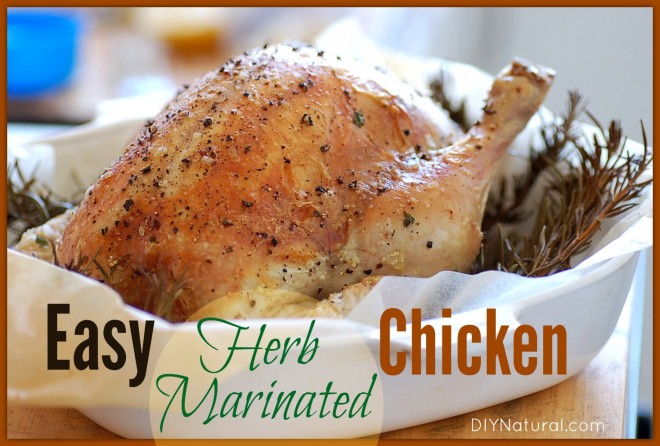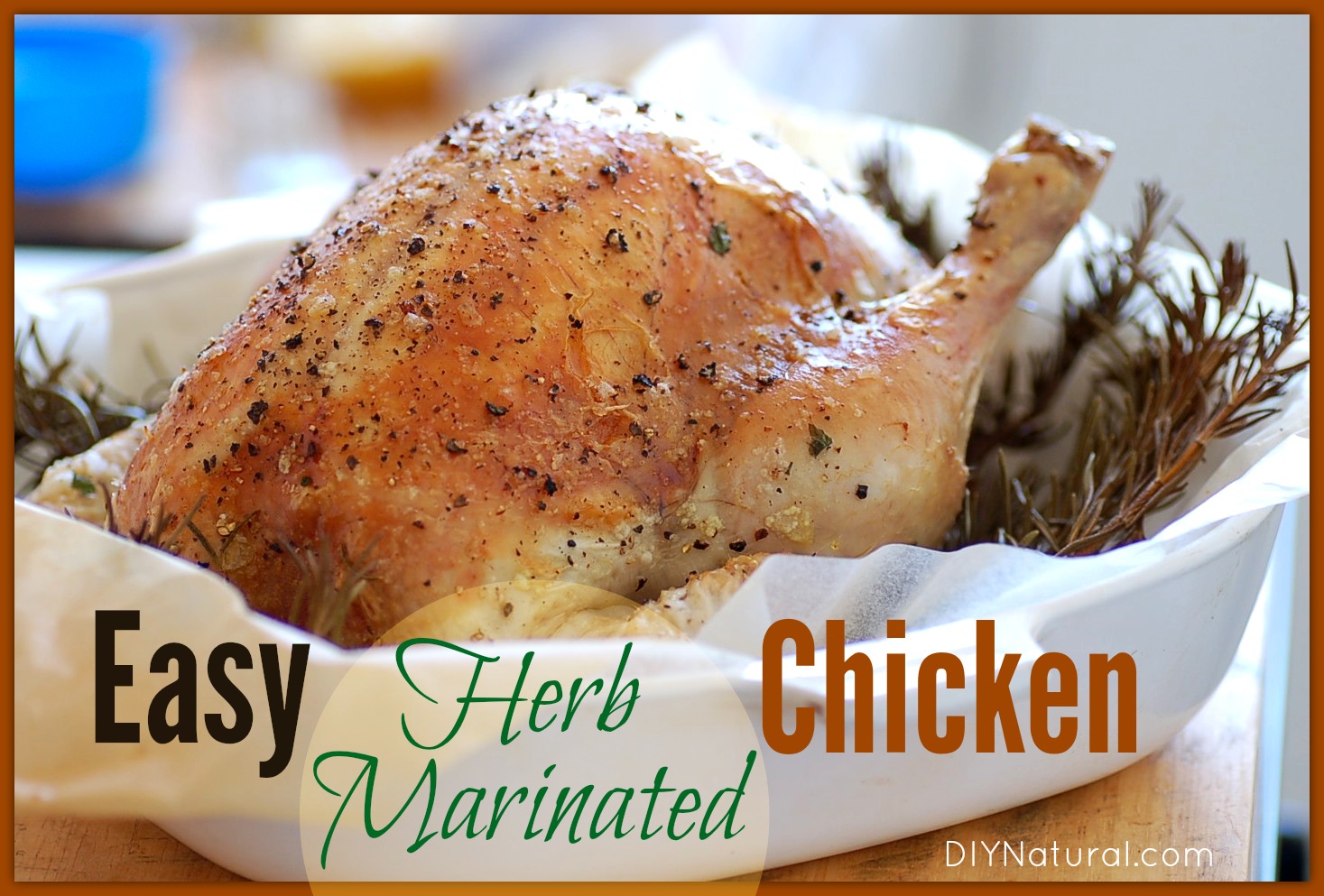
Every spring I’m faced with herbs that I’ve grown that have, well, lost their luster. Parsley that’s about to bolt, cilantro that came too early and is wilted, or ginger that’s limp. So what do you do with these things that are still usable, but unappetizing by themselves? I’m making herb marinated chicken.
Prepare the chicken
Before gathering your herbs, be sure to take the chicken out of the freezer to thaw, or out of the refrigerator. You can use either, but frozen chicken will take longer. Rinse off the bird and cut it into sections, using a clean cutting board. I like to leave the breast and wing together and then the leg and thigh. This ensures everyone will get a nice portion.
When your chicken is clean and sectioned, set it aside for a few minutes.
Take time to disinfect your cutting board after cutting the chicken. I use a few drops of rosemary essential oil diluted in water with a tablespoon of alcohol to clean my boards. (No bleach or harsh chemicals needed!) Rosemary will kill just about any germ while adding a nice scent to the board. And if some gets on the next project, hey, extra flavor!
Prepare the herbs
- I enjoy using soy sauce for the salty component – a quality brewed soy sauce. This type is one of my favorites. It contains soy sauce, citrus (I like the lime one), sugar and vinegar mixed together to make a unique sauce. The Japanese call it umami, or a savory taste.
- Then I add some grated ginger from my piece that’s gone soft. Grate what you need and freeze the rest in one piece. It’ll be easier to grate the next time. You can also use ginger powder, but you’ll lose the fresh flavor.
- Chopped cilantro is next. Cilantro goes limp easily and is best when used right away. If you can’t use all you have, chop it and put it into ice cube trays and freeze. Pop them out and store in a plastic bag in the freezer. It will taste just like fresh cilantro when used in future recipes.
- My rosemary died in the extreme cold this winter, but the leaves are still good. Crush or chop a handful of rosemary leaves and add it to the mix.
- Grind some fresh pepper and add this to your mixture.
- I have a few limes and tangerines that are going bad. (I tend to buy too many at a time.) Halve them and use a citrus reamer to get out all the juice. Don’t have one? You can also use a fork, which almost as well. I use one lime and one or two tangerines. Oranges would work too, just use half of one.
- Lastly, add about a quarter of a cup of oil to each cup of soy sauce. One cup will work for an average chicken, and you can adjust accordingly. The type of oil doesn’t matter. I use sesame oil, or sometimes olive or sunflower. Just be sure it’s a good quality oil.
Mix all of the ingredients together. Then place your chicken skin side down in a gallon size zip-top bag. Add your marinade mixture, covering all of the parts of the chicken. Seal the bag, forcing out as much air as possible. Place this in a roasting pan and leave in the refrigerator overnight. (Don’t leave it on the counter to marinate. It must be refrigerated.) I usually take the bag out and redistribute everything inside a few times to be sure the marinade gets into all of it.
Cooking the chicken
This is the part you can have the most fun with. The next day take the chicken out and give it a light rinse. You can leave the herbs on it, but since mine had tangerine seeds and outside husks of ginger, I got rid of that. Then you can fry it on the stove, bake it in the oven or grill it on the grill. Grilling is my favorite way to cook it since it gives it more flavor.
I rarely use a thermometer. The method I like the best to check for doneness is to jab a knife in the thickest part of the meat down to the bone. If the juices run clear, it’s done. If the juices are pink or red, continue cooking. Even when the juices are clear, I still leave it a while just to be sure it’s really done.
Serve this chicken with a fresh tossed salad, using some of the same herbal components in the dressing. Add some baby potatoes broiled in butter and parsley (use up that wilted parsley!) and some roasted root vegetables like carrots and parsnips. Top off the dinner with a cobbler or crisp, such as my Dad’s rhubarb crisp (find the recipe here) and enjoy!
Have you used herbs that aren’t quite prime in a recipe? Tell us what you did!
*******
photo credit to Jules




Why on earth would you ‘rinse the bird’ I always pat it dry with a clean dry tea towel, drizzle it with extra virgin olive oil, then my desired seasonings/salt. Stuff the insides with chopped onions, or apples, or other, depending on the desired flavors. 🙂
Thanks Laurie! I’ve never tried Bragg’s seasonings, though I have seen them. I’ll have to give them a try. I think that just about any sweetener would work, since you won’t be using a lot of it. The sugar does help in the browning process, but it doesn’t have to be brow to taste good. And it may just do that on it’s own anyway. And I couldn’t get by without my reamer. I use it at least a few times a week.
Hi, all,
This comes from a “mature” reader (read over 65). I buy my chickens from a local grower – range free, organic fed. The buyers help process the birds (having done autopsy assists in my former life, this is NOTHING). The SMALLEST of the birds were just under 6# – the largest were running 8#!!! Biggest batch yet, mostly they range from 4.5 to 5.5#. Anyway, had to chuckle on your comment about leaving the wing on the breast and other parts together for a “nice serving”. Of course, you are correct for a “normal” size bird, but the breast alone on one of these birds feeds me for 2-3 days!
Love the recipe and the ideas of how to use/save the “less than perfect” herbs. I’ll be adding those to my herb usage.
Personally, I prefer Bragg’s Aminos instead of soy sauce – healthier and taste is wonderful. Of course, for those of us who try to avoid carbs – esp sugar, for health or other issues, stevia or xylitol would make great replacements for the sugar.
I am tickled to have the info on the reamer, as I was just about to replace my lime squeezer, and this looks like a much more versatile option.
Thanks for all your great ideas.
I always enjoy reading about your ideas but today I thought I would add a little comment about ponzu, which you seem to consider to be a type of soy sauce. To a Japanese, ponzu is a type of vinegar. In fact, ‘zu’ in ponzu means vinegar. Soy sauce makes up roughly half of ponzu. Here’s a recipe I found. You can skip kelp and bonito flakes although they definitely add umami.
http://dinersjournal.blogs.nytimes.com/2009/02/19/recipe-of-the-day-ponzu-sauce/?_php=true&_type=blogs&_r=0
Thanks for pointing that out, Nori. I’ve used ponzu in place of soy sauce, but you’re right, it’s not the same thing. It’s a condiment all onto it’s own.